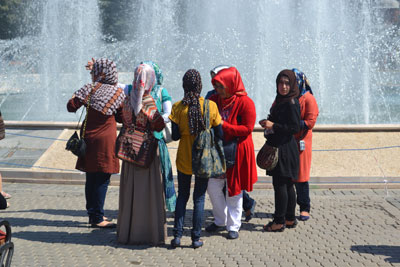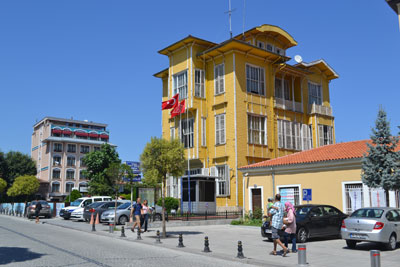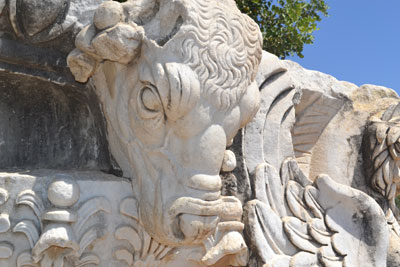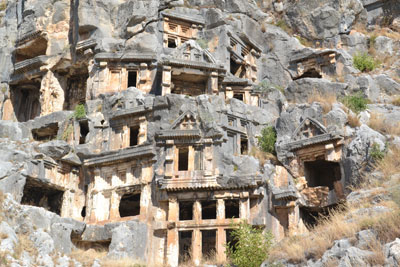From mountain passes to the Turquoise Coast, rediscovering Turkey on a custom tour
This item appears on page 34 of the September 2013 issue.
by Bill Altaffer; San Diego, CA
My visit to Istanbul was an eye-opener. It was modern, vibrant, clean and on the move but without having lost any of its historical and cultural identity or charm. Straddling both Europe and Asia, it is a blend of the best of the East and the West.
Now, in all but the most remote areas of the country, modern and clean restrooms with Western-style toilets have replaced the unpleasant floor toilets that I remembered vividly from previous visits. That, alone, was a huge surprise and perhaps the most obvious of the many, many changes I encountered as we circumnavigated this fabulous nation.
Istanbul to Izmir
Our small group was on a tour arranged for August-September ’12 by MIR Corporation of Seattle. We spent our first couple of days in Istanbul, enjoying the ultramodern Legacy Ottoman Hotel, a 5-star property located in the Old Town very close to the Galata Bridge.
From this convenient location, it was a short walk to the Blue Mosque and the Grand Bazaar and we could easily explore the city’s ancient fortress wall, viewing the luxurious homes and condos rimming the Bosporus Strait.
I enjoyed the extensive buffet breakfast in the hotel’s top-floor restaurant, where there were impressive open-air views of the strait and Istanbul’s new town on its opposite bank.
After our first breakfast we met Tolga Kanik, who soon moved to the top of my list of exceptional tour guides. We set off by foot up the busy hill to the Blue Mosque and Hagia Sophia.
Close by, we descended into the huge Basilica Cistern, where water was stored in ancient times. It was remarkable, featuring an incredible sunken forest of columns rising from the shallow water to the cistern’s roof and capable of holding around 20 million gallons of water.
Our afternoon ended with a pleasant boat ride on the Bosporus, cruising between the shores of Europe and Asia. These banks are studded with ancient buildings and the massive modern homes of Istanbul’s elite.
Wherever we ate during our trip, even in the most basic cafés, food was delicious, well prepared and even healthy, including fresh ingredients and grilled meats, with nothing fried or greasy.
Leaving Istanbul, we flew by Turkish Airlines to Izmir. We were met on arrival by our driver with a comfortable 10-person minivan — far more room than our small group of three needed.
Ancient sites
Turkey is covered with ancient ruins, most ravaged by earthquakes and the passage of time. After stops at Didyma, a small seaside resort with the remains of the eighth-century-BC temple of Apollo, and the Greek ruins of Priene, we arrived in Selçuk, where we would spend a comfortable night in the first of many charming boutique hotels.
In the morning, we drove the short distance to Ephesus, well worth a day of exploration. Covering about 100 acres, it is one of the greatest archaeological sites in the world and features marble streets, public baths and many monuments.
After a wonderful lunch served in the courtyard of a family home, we visited the Ephesus Archaeological Museum, which safely preserves and displays many of the treasures, statues and artifacts found in and around Ephesus.
The next morning we visited Pamukkale, a UNESCO World Heritage Site. The 600-foot-high cliff of what look like calcified waterfalls, formed by the same process that creates stalactites and stalagmites in limestone caves, makes this a unique and beautiful site.
Coastal cruise
An all-day drive through picturesque countryside brought us to Fethiye, a fishing and yachting port. There we boarded the Amazon Solo, a gulet, a small, traditional masted sailing boat, on which we would explore the Turquoise Coast. The gulet was very comfortable, with en suite baths, air-conditioning and a small crew who took excellent care of us for the next three days.
First we sailed to Gemiler Island, known as St. Nicholas Island, where we moored for the night. This tiny island, where St. Nicholas preached for several years, is covered with the ruins of many churches built to accommodate the hordes of pilgrims who stopped there on their way to Jerusalem.
Following a superb breakfast on deck, we began our leisurely, totally decadent Mediterranean cruise in earnest. Each evening we anchored in a different private, idyllic cove where we could swim in the crystal-clear, tanzanite-colored water while dinner was being prepared.
During the day we cruised slowly, periodically stopping for shore walks to ruins or to swim again. Once, we swam into a cave that would rival the Blue Grotto.
Along the way, we saw the remains of a Lycian city destroyed by an ancient earthquake and explored a village with no road access and the remains of an old Roman fort. We passed lovely little villages with traditional whitewashed buildings and red-tile roofs, very much the idealized Mediterranean scenery, as we sailed eastward along Turkey’s southern coast.
Each meal on board was excellent, with fresh fruits and vegetables perfectly prepared just for us.
After three nights aboard the ship, we reluctantly said good-bye to our crew at Kaş, a small fishing village, where we were reunited with our driver and minivan. In Myra, we visited the eighth-century church of St. Nicholas, who served as bishop and was buried there. For that reason, it is a pilgrimage site for Russians, who arrive in droves to pay homage to a saint they revere.
Cappadocia
Moving on along the Silk Road, we stopped for a break at the Sultanhani Caravanserai, built in 1229 as a stopping point for caravans. Caravanserais dot the countryside at regular intervals, originally serving as refuges where travelers could overnight in safety from robbers.
Our destination was one of the highlights of the trip: the region of Cappadocia. Three million years ago, active volcanoes led to the creation of the strange topography for which the area is known. Basalt and tuff from their eruptions were eroded by wind and rain into what are called fairy-tale chimneys, in fantastical shapes.
Since 1600 BC, cave homes and hidden underground complexes have been easily dug from the soft volcanic tuff. We explored one that was 3,000 years old. Able to accommodate 3,000 people, it was a warren of rooms and passageways going down about 240 feet, with living quarters, chapels, communal kitchens, wine-making rooms and rooms for grinding wheat. It was fascinating.
The area of Cappadocia is a draw for tour groups. Hundreds of hot-air balloon operators compete for business, and many ceramics stores offer demonstrations of traditional wheel-thrown pottery and, of course, visits to their showrooms for shopping.
The fairly-tale chimneys went on for miles in every direction. Our wonderful boutique hotel featured two rooms carved into the rock.
Göreme National Park preserves some of the many Christian monasteries dug into the chimneys, with cave churches beautifully frescoed and decorated in Byzantine splendor.
In a neighboring village, we had another wonderful lunch in a family home. These meals are a tradition of MIR Corp. and are highlights of their trips. It adds so much to an experience when you meet people in their own homes, see how they live, visit with them and are treated to a meal of the food they eat.
Into the mountains
Leaving Cappadocia reluctantly, we spent the day going up and down mountain passes, working our way to the eastern end of the Taurus Mountains. In the modern university city of Maras, we made a memorable stop at a large restaurant featuring Turkish ice cream. Made with orchid root powder, it doesn’t seem to melt and, for that reason, is served with a knife and fork rather than a spoon. It tastes like ice cream; it just doesn’t behave like it.
Close to evening, our van made a final climb high up into the mountains to our hotel, a basic property perched with a spectacular view of a beautiful, wild and rugged valley.
We were up early the next morning and climbing even higher to the top of Mt. Nemrut, where we hiked the final 600 feet up to the ruins of Nemrut Dağ, a monument constructed by Antiochus I in the first century BC.
Antiochus had recontoured the top of this remote mountaintop, creating a gracefully symmetrical 150-foot dome of small white limestone rocks to cap it. At the base of the dome, he created terraces that held seated monumental stone statues. Though very different in scale, they reminded me of the moai of Easter Island.
The site was very impressive and well worth the strenuous climb at the high altitude.
We stopped next to see the exquisite, beautifully preserved reliefs of Arsemia before taking a ferryboat across one of the many lakes formed by dams on the Euphrates River. The ferry was packed solid with big trucks. The trip across the lake was like a Disneyland “E” ticket ride as we bobbed like a cork in the sea.
Toward evening we arrived at Diyarbakir, with its intact, ancient, 40-foot-high wall still protecting the Old City, where we found our hotel, the 600-year-old Hotel Büyük Kervansaray.
Crossing the Tigris River in the morning, our group headed for Lake Van. The city of Van has passed from empire to empire since its origin as the capital of the ancient Urartu Empire in the ninth century BC.
We took a boat to a small island in the middle of the lake to see the 10th-century Church of the Holy Cross. Constructed of pink sandstone, this Armenian church displays high-relief carvings on its exterior. They illustrate scenes from the Old Testament in astonishing detail.
From there, our drive along the Iranian border took us to Doğubeyazıt, a Kurdish town set in the shadow of Mt. Ararat. Our hotel for the evening was basic, in a quiet spot a few miles from town. A breathtaking view of Mt. Ararat filled the windows of my room, more than making up for any lack of amenities in the hotel. Waking up to that sight was awe-inspiring!
Head in the clouds
Continuing our circumnavigation of Turkey, we were close to the Georgian border as we skirted the beautiful alpine Lake Çıldır with its necklace of wildflowers. We hiked along the side of a canyon with gorgeous views.
Numerous eagles circled overhead as we approached the remains of the Devil’s Castle, a powerful stone fortress in a nearly inaccessible spot. We also drove by Lake Atkas, lying half in Turkey and half in Georgia.
Moving on, we continued to climb higher until we reached the top of the mountain pass at an elevation of 8,000 feet. Then everything changed. We entered a different world.
For many days as we had traveled north along the western edge of Turkey, we had been in arid, wide-open, treeless countryside. As we edged over the mountaintop, we were suddenly driving through a bank of clouds formed because moisture from the Black Sea condenses there instead of passing over the mountain.
The temperature dropped and we found ourselves surrounded by a thick forest that could only be described as Swiss-like, with lush green conifers. The road featured sharp, hairpin curves as it wound downward.
Our log-constructed hotel, still high up on the mountain, added to the distinctly Alpine feel of the area.
From there, we drove through tea plantations down to the shore of the Black Sea. The very modern road provided easy passage through the north of the country along the Black Sea, but Tolga said that its construction had destroyed many prime sandy beaches and old, classic wooden homes. He felt that the destruction of the beaches had been a deliberate act, a deterrent to women appearing in public in bathing suits. This was a reminder that, though Turkey is a secular state, there still are occasional signs of conservative Muslim beliefs.
At Trabzon, we left the coast to rise again up a mountainside to the impressive Greek Orthodox Monastery of Sumela, clinging in fog to a steep cliff in a thick forest. Atmospheric and almost mystical, it is a small complex of stone buildings built next to a domed cave on a widened ledge high up on the cliff face. All surfaces, inside the cave and out, are covered with intricate religious frescoes.
After a last night in a hotel up on the mountainside, we descended back to Trabzon to explore the sites in this, the largest port on the Black Sea.
In capable hands
Following lunch, we boarded our flight to Istanbul to complete our circumnavigation of Turkey. We had our farewell dinner while reflecting on our excellent tour, which had been dreamed up by me, put together by Dmitry Rudich of MIR Corporation (phone 800/424-7289), implemented by Amber Tours in Kaş¸ and carried out by the world’s best tour guide, Tolga Kanik.
Tolga, besides being very personable and dealing in an excellent manner with all the logistics, details and problems of his job, is passionate about his country. He was trained in the US as an EMT, has a degree in petroleum engineering and possesses an intensive knowledge of history, culture, geology, birds, natural sciences and religion. There was very little of which he did not have a good understanding.
With his apparently perfect memory and ability to articulate and impart information, he filled our heads with far more interesting information than we could possibly retain.
Our driver was also outstanding. We all have had experiences with scary drivers in foreign countries, but this driver was always safety conscious.
Our 24-day trip cost close to $10,000 per person, not including international airfare.
Turkey, a center of ancient, classical and modern civilization, is a wondrous country anyway, but with our excellent driver and the guidance of Tolga, we could not have had a better trip.






